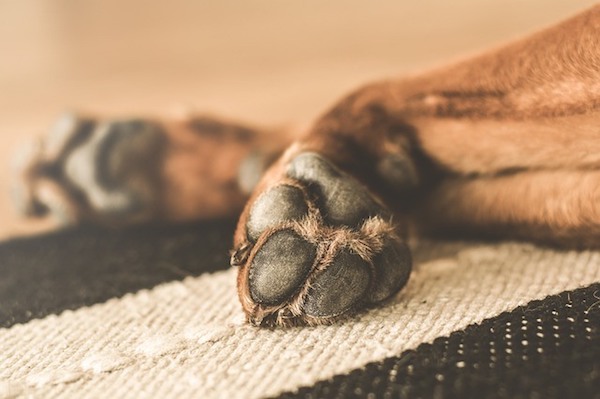
It’s a curious thing.
Toes on an Australian Cattle Dog should be held close together, while on an Australian Shepherd, they should be well arched. On a Bearded Collie, the toes should be close together and arched.
In all the Belgian Sheepdogs, toes should be curved close together, but rear toes on a Beauceron should point slightly outwards, and on a Basset Hound, the toes are neither pinched together nor splayed.
A Chinook should have webbing between the toes, while two toy breeds, the Pug and the Chihuahua call for well split-up toes, and by this is meant a distinct and deep separation of individual toes from each other (sometimes this is called “well split up feet).
Azawakh have tightly closed toes, as does the Dogo Argentino whose standard calls for “very tight toes.”
Toes. We don’t always give them much thought (until it’s time to trim those toenails), but they are what connect a dog to the ground it stands on, so yes, they matter. Dogs are digitigrade animals which means that their toes, not their heels, bear most of their weight when they walk. And if they’re a sighthound, toes can make the difference. Virtually all sighthounds have hare feet that are elongated because the two center toes are longer than the outer toes. More energy is needed to move these paws, but they increase speed which is what a sighthound needs.
Many water working dogs such as Newfoundlands and Labrador Retrievers are said to have long toes, and some breeds have five toes on their hind feet (most accurately called polydactyly), something that scientists at the Korean Research Foundation and the Korea Science and Engineering Foundation came to decide was a reversion from the evolutionary loss of the toe.
In 2007, an article published in Clean Run magazine documented the incidence of sports related injury in dogs participating in agility, either while competing or in training, and a survey determined that trauma of the digits accounted for 6-8% of reported injuries, depending on the breed. The significance of the report is that paws seem to be inversely proportionate to athletic ability.
After learning about dog toes, it’s a marvel that toe injuries aren’t more common. Each toe is made up of three small individual bones with the exception of the dewclaw, and that one has two. The tip of the most distal bone becomes the nail bed.
Toes also have an intricate network of tendons and ligaments which can become injured. The fibrous cords that attach muscle to bone are the tendons. Coming from the various muscles of the forelimb, they run underneath the toes as “flexor” tendons, and on top of the toes as the “extensor” tendons.
Another important tendon is the superficial digital flexor tendon that acts somewhat as a shock absorber for the impact of the dog hitting the ground, but it also allows the toe nails to “dig in” for traction. Toes also have ligaments, bands of fibrous tissue connecting bone to bone to form a joint. Collateral ligaments run on the medial and lateral aspect of the toes, and provide side to side stability.
When a dog runs, it’s going to have difficulty in getting “traction” on some surfaces, especially set, slick, or highly polished ones, if they have too much hair between their pads, what some people call “foot fur.” To help the dog get the greatest amount of contact between the pads of his feet (responsible for most of the gripping) and the surface, trimming that hair is vital, especially if the dog is competing in a sport like agility. Even conformation fanciers know the hazards of a slick concrete floor, it’s why anti-slip products exist. Some pet owners whose homes have hard wood or granite floors go so far as to purchase a product like Pawfriction, a coating system that increases traction. Is it really necessary? Well, have you ever driven a car in the rain with bald tires? Yeah, that.
Some breeds mention hair between the pads in their standard. The Havanese standard calls for hair on the feet and between the pads to be neatly trimmed, while the Cavalier King Charles Spaniel’s standard merely states that hair growing between the pads on the underside of the feet may be trimmed.
Toes. They’re little, but important, and it’s important to know what your breed’s standard says about them.
